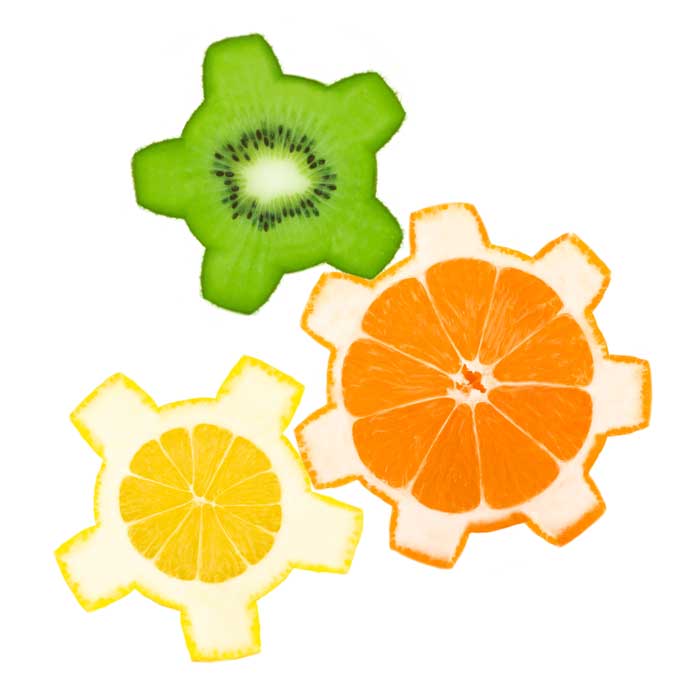Hydrocolloids
The sensory enjoyment of food and drink is an holistic experience, and is achieved through the combination of all its organoleptic qualities including the texture and mouthfeel.
To achieve, enhance, modify or stabilise the specific texture or mouthfeel of a product, functional ingredients such as gels, thickeners or stabilizers are used. The functional ingredients that are used as gels and thickeners are typically Hydrocolloids, i.e. substances which form gels in the presence of water. Starch is arguably the most important hydrocolloid in the food industry, but others are widely used depending on the required function and application. Hydrocolloids deliver mouthfeel through dispersion, hydration and swelling of the particle and water is ultimately trapped in the 3-dimensional network of the hydrocolloid. The commonality between all of these functional ingredients is the long-chain polymers, which, through cross-linking will create pockets within the gel network, which encases the water. This allows comparatively large amounts of water to be held by low levels of the hydrocolloid.
These can be identified on an ingredient label by the ‘E-number’ in the range E400-E499; For example: Sodium Alginate (E401) is classed as a thickener, stabilizer and gelling agent, and; Methylcellulose (E461), which is used as an emulsifier and a stabilizer. Some of the thickening agents, such modified starches, can also be found in the E1000-E1599 range.
An improvement in texture and mouthfeel can enhance the perception of ’juiciness’ or ‘fullness of flavour’. Gels and gums such as pectin (E440), guar (E412) and xanthan (E415), are widely used to enhance the ‘fullness’ of low- and no-sugar beverages. Methylcellulose is becoming an important ingredient in some plant-based meat products to help provide the stable structure and create the meat-like texture.
Another key hydrocolloid, which has been widely used, is of course gelatine. Gelatine is soluble protein derived from collagen, typically beef, pork or fish collagen. One of the properties that gelatine possess, which has made its direct replacement a challenge, is its ability to form thermo-reversible gels; gelatine will form a strong gel but will ‘melt’ in the mouth creating desirable eating characteristics. Gelatine does however present a challenge for the pure vegan and vegetarian markets, but of course could still have application benefit in the emerging ‘hybrid’ and meat-reduced product category, where the largest proportion of consumer still reside.
Functionality
As with any application, the specific function of the hydrocolloid needs to be considered such as the desired texture, the final viscosity, whether it is a pourable sauce or a firm gel. This will influence the specific hydrocolloid selected, for example methylcellulose can be used to create the firmer texture desired for a plant-based dairy cheese or ice cream, but a starch would be used to create a smooth, thickened, sauce, achieved through hydration of the starch granule (gelatinisation), without the formation of a gel.
Ingredient Interactions
Of particular importance is the interaction with the other ingredients used within the product, as these will affect the gel characteristics and performance of the hydrocolloid. For example, pectins used for Turkish Delights are ‘acid-set’ gels and will only form in low pH environments, ideal for confectionery, but not necessarily other product applications, where the presence of an acid will trigger a rapid setting reaction. The formation of a sodium alginate gel is facilitated by the presence of calcium ions which facilitate the cross-linking between the polymer chains, so care must be taken to understand the components with a product which may alter its functionality or performance. This also demonstrates the need to consider other aspects such as ionic concentrations within process water.
The presence of acids, fats, gels, sugar and proteins will all impact on starch performance:
- Acids can cause the breakdown of the gel structure. This is used to positive effect in canning where filling viscosity is higher than the desired final viscosity.
- The additive effect of gum addition to starch is exploited to achieve specific flow characteristics.
- Sugar and protein will compete for water and weaken gel strength.
- Fats can improve the mouthfeel of the gel.
Starches are often modified to overcome some of the limitation of native starches. This enables their use across wider range of process parameters and broadens their functionality through enhancing their positive attributes such as reducing viscosity, allowing the use of starch with higher solids content, increase solubility or controlling gel strength.
Kokumi
As discussed previously, sensory perception is the result of a combination of organoleptic attributes, and texture and mouthfeel are an essential component of that. Much like Umami, the so-called ‘fifth taste’ which is understood and utilised in the development of savoury products, another Japanese sensory concept, Kokumi, is now on the radar in terms of understanding the importance of texture, in the wider context of sensory perception. Although associated predominantly with taste, kokumi is also about texture. It can boost the mouth-coating sensation from fat-containing food materials such as a dairy emulsion. It can increase the roundness of a flavour, much like salt does traditionally, and amplify sweetness in reduced-sugar products.
Plant-Based opportunity
The food and beverage industry is undergoing something of a revolution. For the first time in possibly 50 years, since the change in households’ culinary habits, social change and the shift to convenience enabled by home-freezers, microwaves and the one-stop shop supermarkets, there is a quantum shift in the range of products being introduced into the market place. These are in the form of plant-based products, which are being developed from emerging and established technologies. Crucially these products are being developed from the ground-up. This requires careful consideration of each component and the contribution it makes, and what can be utilised to ensure that plant-based meat and dairy alternatives still deliver the sensory experience that consumers expect. The philosophy behind Kokumi and the role texture plays is therefore essential in the development of flexitarian products from plant-based dairy to alt-meat products.
Consumers will however need to adapt to the ingredients being utilised. Whilst every effort is made to ensure that the plant-based products are developed using ‘natural’ and ‘clean-label’ ingredients, misconceptions about the essential functionality and the chemical sounding nature of some of those ingredients may inadvertently hinder the development of great products. Afterall, Methyl cellulose is from plants, Sodium Alginate from Seaweed and Xanthan gum isn’t bad because it has an ‘X’ in it….
Through its ACTION: Food Technology Scouting platform, The Aurora Ceres Partnership Ltd is ideally placed as Food Industry Experts to help identify the right technical solution for your innovation projects.



